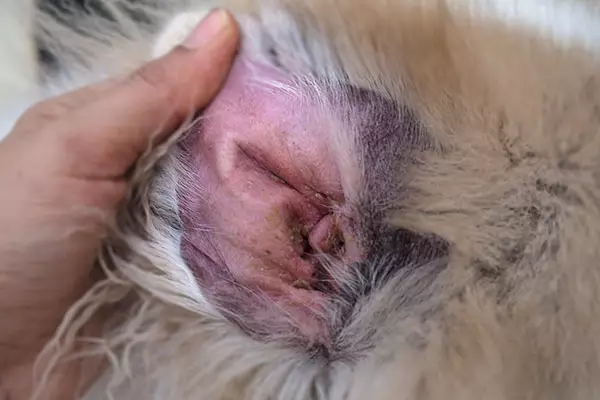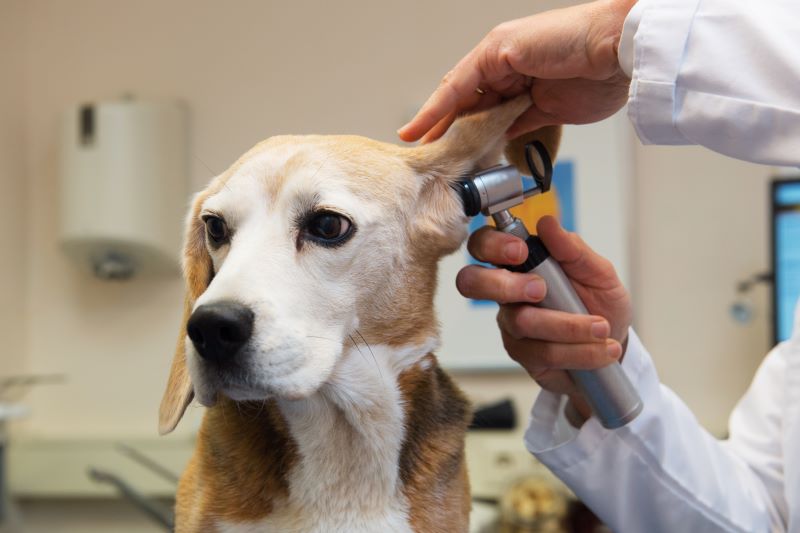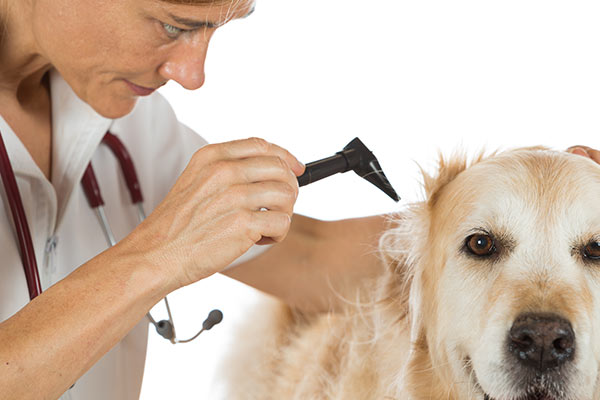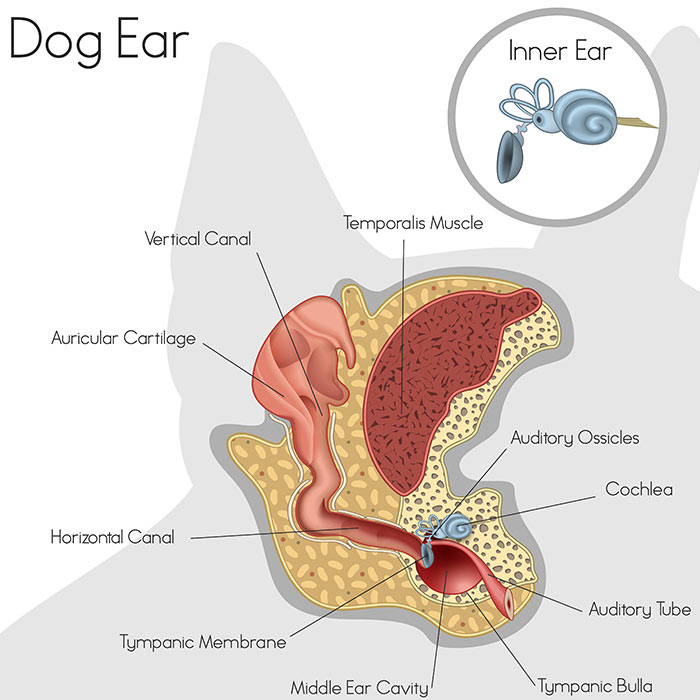Signs & symptoms of ear mites in dogs
What are ear mites in dogs?
Ear mites are small parasites that can infest a dog’s ears. They are tiny, spider-like creatures with the scientific name Otodectes cynotis, which are related to spiders and ticks. Ear mites in dogs are barely visible to the naked eye, being less than half a millimetre in length.
Ear mites in dogs are relatively common. They live inside and around the ear canals and feed on the skin and wax inside the dog’s ears causing inflammation, irritation and discomfort. They live on the surface of the skin and don’t burrow into it as some types of mites do.
Mites in dogs ears can lead to secondary infections if left untreated, so it’s important to take prompt action if you suspect that your dog has ear mites.
Cost of ear mites in dogs
| Average claim costØ | Highest claim costØ |
| $185 | $726 |
ØBased on PetSure claims data, 2022 calendar year. Reimbursement for these claims under a pet insurance policy would be subject to limits, such as annual benefit limits or sub-limits, benefit percentage, applicable waiting periods and any applicable excess. Cover is subject to the policy terms and conditions. You should consider the relevant Product Disclosure Statement or policy wording available from the relevant provider. Please note that values calculated are based on all claims for that condition and medically related conditions in each calendar year.
Because it is difficult to predict the costs of veterinary care, it can help to have measures in place to help prepare for the unexpected. Pet insurance can help by covering a portion of the eligible vet bill if the unexpected does happen.
Get a quote for 2 months free pet insurance for your puppy or kitten in their first year.
Causes of ear mites in dogs
Ear mites are highly contagious and spread from one dog to another through close contact. They can also be transmitted to other animals, such as cats, rabbits or ferrets.
 Ear mites can affect dogs of any breed, age, or ear type, but they may be more common in dogs with floppy ears. This is because floppy ears can create a warm and moist environment that is conducive to the growth and spread of ear mites.
Ear mites can affect dogs of any breed, age, or ear type, but they may be more common in dogs with floppy ears. This is because floppy ears can create a warm and moist environment that is conducive to the growth and spread of ear mites.
Floppy ears can trap moisture and debris, which can provide a breeding ground for bacteria, yeast, and parasites like ear mites. In addition, the shape and size of floppy ears can make it more difficult for air to circulate, which can further exacerbate the problem.
Dogs with long, heavy ears such as Basset Hounds, Cocker Spaniels and Bloodhounds may be more susceptible to ear mites and other ear infections due to the shape of their ears. However, it’s important to note that any dog can develop ear mites, regardless of ear type.

Symptoms of ear mites in dogs
Mites in dogs ears cause an intense itch. The most common symptoms of ear mites in dogs include:
- Excessive scratching or rubbing of the ears
- Shaking of the head
- Redness, inflammation or scabbing around the ears
- Dark, waxy discharge from the ears
- Strong odour coming from the ears
- Crusting or scaly skin around the earflaps
Similar symptoms can occur in dogs with an ear infection, so it’s important to see the vet for correct diagnosis and treatment.
Puppy and early age ear mites symptoms in dogs

The symptoms of ear mites in puppies are similar to those seen in adult dogs, but may be more pronounced or severe due to the puppy’s smaller size and less developed immune system. Some common symptoms of ear mites in puppies include:
- Excessive scratching or rubbing of the ears
- Shaking or tilting of the head
- Redness, inflammation, or scabbing around the ears
- Dark, waxy discharge
- Strong odour coming from the ears
- Crusting or scaly skin around the earflaps
- Discomfort or pain when the ears are touched or manipulated
Puppies may also exhibit signs of general discomfort or irritability, and may be less active or playful than usual. They may also develop secondary bacterial infections, especially if the ear mites have caused damage to the ear canal or eardrum. Ear mites can be very uncomfortable for puppies and can lead to serious complications if left untreated.
How are ear mites in dogs diagnosed?
If you suspect that your dog has something going on with its ears, it’s important to take them to a veterinarian for the correct diagnosis and treatment.
Ear mites in dogs can be diagnosed by a veterinarian through a combination of physical examination, history-taking, and laboratory testing. During the physical examination, the vet will examine the dog’s ears for signs of irritation, inflammation, or discharge. They will probably use an otoscope to look inside the ear canal and view the mites.
In addition to the physical exam, the vet may also ask questions about the dog’s history, including any recent exposure to other animals with ear mites or any previous episodes of ear infections or irritation.
If the vet suspects that ear mites are the cause of the dog’s symptoms, they may take a swab of the discharge from the ear canal and examine it under a microscope. Ear mites are tiny and difficult to see with the naked eye, but adult mites and mite eggs can usually be identified microscopically.
Treatment of ear mites in dogs
The vet will recommend a treatment plan based on the severity of the infestation and the overall health of the dog. Treatment involves cleaning the ears and administering medication, such as topical drops or oral medication, to kill the mites and prevent a recurrence. Follow-up appointments may be necessary to make sure that the infestation has been fully resolved.

Cleaning the ears
Before administering medication, the ears must be cleaned to remove debris and discharge. This allows the medication to be more effective and helps the ear canal to heal. The vet will clean the dog’s ears and show you how to cleam them yourself at home if necessary. This may involve using a special ear-cleaning solution and gently wiping the inside of the ear canal with a cotton ball or soft cloth.
Administering medication
Your vet may recommend a topical medication, such as ear drops, to kill the mites and soothe the inflamed ears. In some cases, oral medications may also be prescribed to help control the infestation. Topical medication application can range from single-use to up to 30 days.
It’s important to follow the veterinarian’s instructions carefully and complete the full course of treatment, even if the dog’s symptoms improve. Ear mites can be very persistent, and incomplete treatment can lead to a recurrence of the infestation.
Follow-up visits
These may be necessary to ensure that the ear mites have been fully eliminated. The vet may want to perform additional ear cleanings or administer more medication, depending on the severity of the infestation. In some cases, a second round of treatment may be necessary to fully eliminate the mites.
Preventing reinfestation
- Thoroughly clean and disinfect the dog’s living environment, including their bedding, toys, and any other areas where they spend time.
- Speak to your vet about whether it is necessary to treat other pets in the household simultaneously, as ear mites are easily transmitted from one animal to another.
How long does it take to get rid of ear mites in dogs?
The length of time it takes to get rid of ear mites in dogs can vary depending on the severity of the infestation, the age and health of the dog, and the type of treatment used. In general, treatment for ear mites in dogs can take anywhere from several days to several weeks.
With proper treatment, most dogs will show significant improvement within a week or two. The symptoms, such as itching and irritation, may begin to decrease within a few days of starting treatment. However, it’s important to continue treatment for the full recommended duration to ensure that all the mites and their eggs have been eliminated.
Overall, early diagnosis and prompt treatment are key to a successful outcome in treating ear mites in dogs.
Bow Wow Meow Pet Insurance can help protect you and your dog should an unexpected trip to the vet occur.
-
Find out more about our dog insurance options
-
Get an online pet insurance quote
Bow Wow Meow is proud to have been awarded winner of Canstar’s ‘Most Satisfied Customers’ Award in the Pet Insurance category for both 2024 and 2025!
Bow Wow Meow is proud to have been chosen as Product Review’s Pet Insurance Award Winner every year from 2018 to 2025! This is based on 2,995 independent customer reviews (as at 21/01/2025), with an overall rating of 4.3*
Google Review rating = 4.5* (based on 968 reviews)
Trust Pilot rating = 4.6* (based on 531 reviews)
Bow Wow Meow is proud to have been chosen as Product Review’s Pet Insurance Award Winner every year from 2018 to 2025! This is based on 2,995 independent customer reviews (as at 21/01/2025), with an overall rating of 4.3*
Google Review rating = 4.5* (based on 968 reviews)
Trust Pilot rating = 4.6* (based on 531 reviews)
Bow Wow Meow has been chosen as a winner in the Finder Pet Insurance Awards 2024. Finder’s panel of experts analysed over 140 quotes to award our Ultimate Care Plan the winner of the “Pet Insurance – Value” category.














